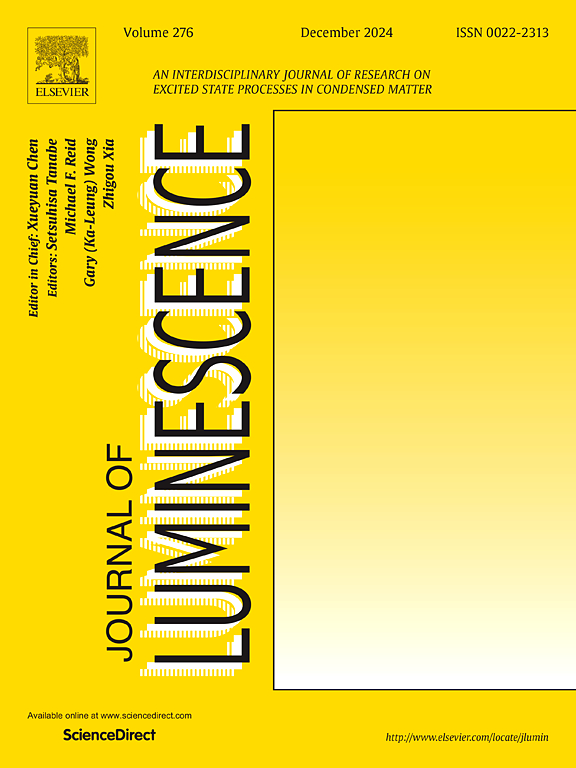Perylene-naphthalene systems: Efficient intramolecular and supramolecular electron transfer in water
IF 3.3
3区 物理与天体物理
Q2 OPTICS
引用次数: 0
Abstract
This study explores novel perylene (PTCA) – naphthalene (SANS) systems for efficient electron transfer in aqueous medium, utilizing both intramolecular and supramolecular architectures. We synthesized a new covalently linked PTCA-SANS dyad, demonstrating highly efficient intramolecular electron transfer (rate: 1.50 × 109 s−1, efficiency: 0.96) from the electron-donating naphthalene unit (SANS) to the electron-accepting perylene core (PTCA) upon photoexcitation. Furthermore, a novel supramolecular system was designed using cationic perylenediimide derivative (TAIPDI) and anionic SANS. Spectroscopic analyses confirmed stable conjugate formation via π−π stacking and ionic interactions (K = 6.11 × 103 M−1). Fluorescence lifetime measurements of TAIPDI upon photoexcitation and subsequent titration with SANS indicated efficient supramolecular electron transfer, characterized by a rate of 7.89 × 108 s−1 and an efficiency of 0.80. In comparison, the photoexcitation of SANS followed by titration with TAIPDI yielded exceptionally fast and efficient supramolecular electron transfer, with a rate of 5.26 × 1011 s−1 and an efficiency of 0.99. Electrochemical measurements and molecular orbital calculations both confirmed this electron transfer characteristic. Both systems are easily synthesized, exhibit broad light absorption and good stability, and achieve rapid, efficient electron transfer in water. These properties highlight their potential for diverse optical and photonic applications.

苝-萘体系:水中高效的分子内和超分子电子转移
本研究探索了利用分子内和超分子结构在水介质中进行有效电子转移的新型苝(PTCA) -萘(SANS)体系。我们合成了一种新的共价连接PTCA-SANS二偶体,在光激发下显示出从供电子的萘单元(SANS)到接受电子的苝核心(PTCA)的高效分子内电子转移(速率:1.50 × 109 s−1,效率:0.96)。在此基础上,利用阳离子过二亚胺衍生物(TAIPDI)和阴离子SANS设计了一种新型的超分子体系。光谱分析证实通过π−π堆叠和离子相互作用(K = 6.11 × 103 M−1)形成稳定的共轭物。光激发和随后的SANS滴定对TAIPDI的荧光寿命测量表明,其超分子电子转移效率为7.89 × 108 s−1,效率为0.80。相比之下,光激发SANS然后用TAIPDI滴定产生了非常快速和高效的超分子电子转移,速率为5.26 × 1011 s−1,效率为0.99。电化学测量和分子轨道计算都证实了这种电子转移特性。这两种体系易于合成,具有广泛的光吸收和良好的稳定性,并在水中实现快速,有效的电子转移。这些特性突出了它们在各种光学和光子应用方面的潜力。
本文章由计算机程序翻译,如有差异,请以英文原文为准。
求助全文
约1分钟内获得全文
求助全文
来源期刊

Journal of Luminescence
物理-光学
CiteScore
6.70
自引率
13.90%
发文量
850
审稿时长
3.8 months
期刊介绍:
The purpose of the Journal of Luminescence is to provide a means of communication between scientists in different disciplines who share a common interest in the electronic excited states of molecular, ionic and covalent systems, whether crystalline, amorphous, or liquid.
We invite original papers and reviews on such subjects as: exciton and polariton dynamics, dynamics of localized excited states, energy and charge transport in ordered and disordered systems, radiative and non-radiative recombination, relaxation processes, vibronic interactions in electronic excited states, photochemistry in condensed systems, excited state resonance, double resonance, spin dynamics, selective excitation spectroscopy, hole burning, coherent processes in excited states, (e.g. coherent optical transients, photon echoes, transient gratings), multiphoton processes, optical bistability, photochromism, and new techniques for the study of excited states. This list is not intended to be exhaustive. Papers in the traditional areas of optical spectroscopy (absorption, MCD, luminescence, Raman scattering) are welcome. Papers on applications (phosphors, scintillators, electro- and cathodo-luminescence, radiography, bioimaging, solar energy, energy conversion, etc.) are also welcome if they present results of scientific, rather than only technological interest. However, papers containing purely theoretical results, not related to phenomena in the excited states, as well as papers using luminescence spectroscopy to perform routine analytical chemistry or biochemistry procedures, are outside the scope of the journal. Some exceptions will be possible at the discretion of the editors.
 求助内容:
求助内容: 应助结果提醒方式:
应助结果提醒方式:


